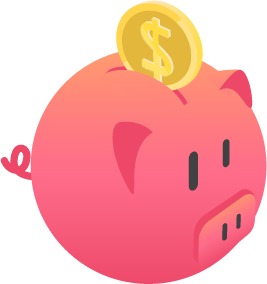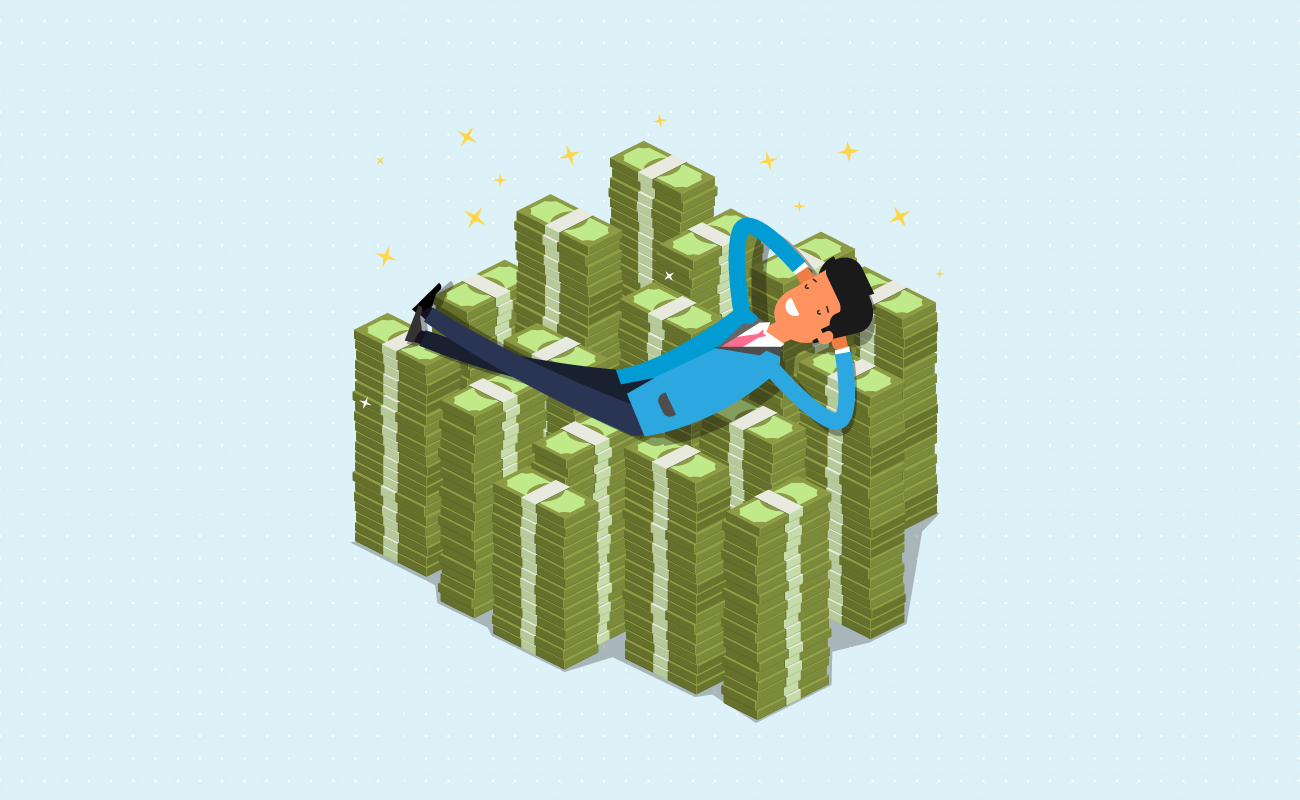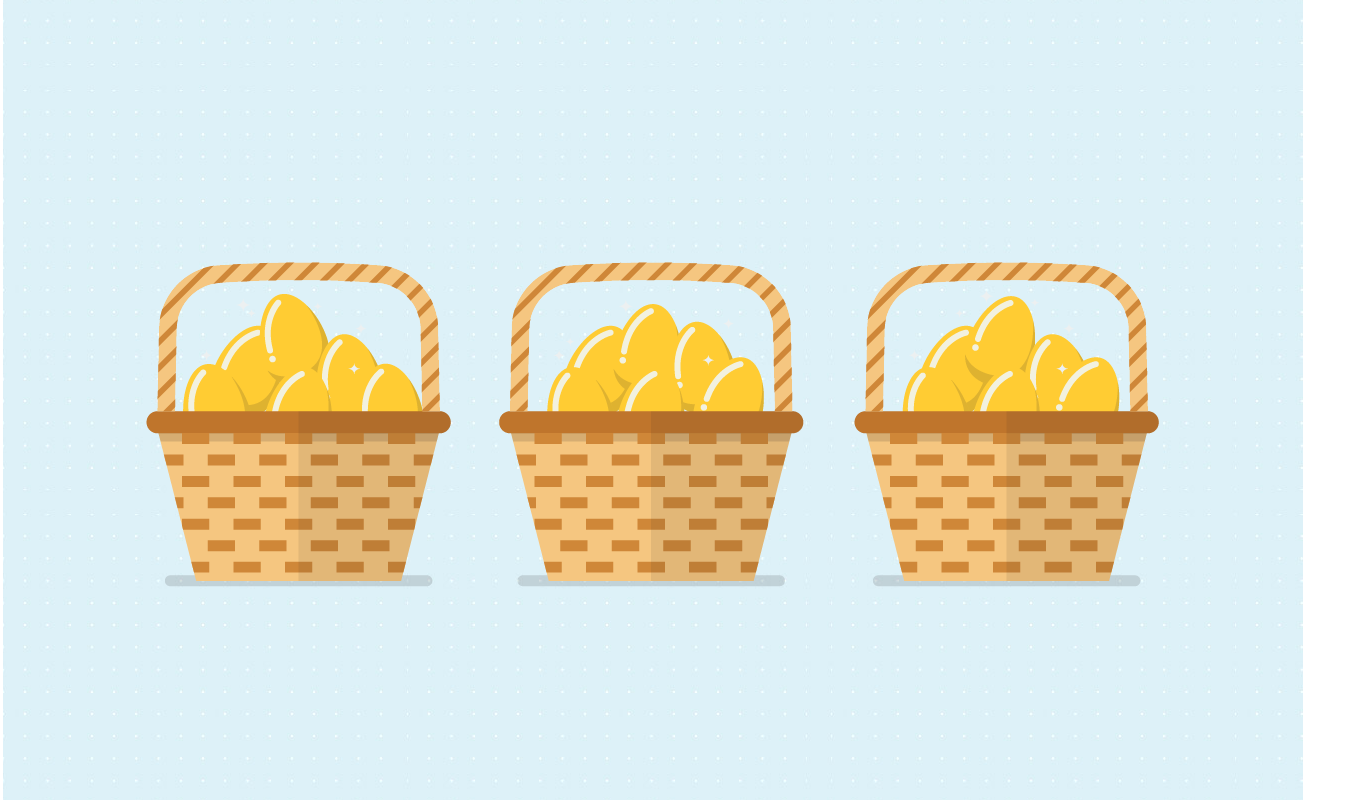Savings Goals
Net Worth
 Interest Savings vs Withdrawal Calculator
Interest Savings vs Withdrawal CalculatorThis calculator helps investors see the long term effects of compound interest by comparing the effects of reinvested interest earnings against interest which is withdrawn as it is earned.
Note: This calculator uses monthly compounding. Most banks compound interest monthly based on the daily average balance for the preceeding month.
Guide published by Jose Abuyuan on November 20, 2020

A lot of people dream of retiring early. Who wouldn’t want to provide for themselves without ever needing to work for the rest of their lives. Circumstances, of course, makes this feel more like a pipe dream. Economic conditions and debt problems have put the squeeze on the ability to save.
Such a life is, in fact possible, given the right circumstances. Having enough money invested early on can give you a massive nest egg that generates a lot of interest. With enough money invested, you can live off of your interest. This way, you never need to worry about depleting your retirement funds. And if you’re still young, you have a massive head start to make this possible.
Money you make from interest is one form of passive income. This common financial buzzword finds its way in all sorts of questionable contexts. But what does it mean? In the proper context, it is a category of money-making that involves no direct involvement on your part. Besides investment income interest, the term also encompasses other income streams, such as the following:
In some cases, passive income may even include large sums of windfall money. For the sake of this article, however, we will focus on regular income streams you don’t need to work for. As the name suggests, it’s money you didn’t have an active hand in earning. It stands in contrast with money you make from a job or business. It’s money you set on autopilot.
It sounds too good to be true, because it is. Only if you’re willing to work smarter and harder for it. The way people frame passive income is often deceiving. It’s often framed thus: “money you didn’t need to work for.” But nothing could be further from the truth. As the saying goes, you need money to make money. To start up a passive income stream, you often need to rely on savings you’ve earned through active means.
“Passive” also doesn’t mean “hands off.” Sometimes, you must give your investments the requisite attention to keep them profitable. Rental income, for instance, demands the upkeep of the rental property. You’d need to keep your building decently maintained to ensure the comfort of your tenants.
Having at least a few passive income streams is the key to long-term financial security. Upon retirement, you must rely solely on passive income. Thus, it’s important that your main source of passive income (your nest egg) is up to the task.
A lot of listicles online often include YouTube ad revenue and e-book royalty payments as part the passive income repertoire. However, these options are not as effortless as they seem. Recent changes to YouTube’s algorithms, for instance, mean you must create more content to keep up this income stream. E-book writers need to market their books before they can be assured of steady sales. That’s a lot more work than your usual passive income source.
That said, these streams can become passive once you’ve done enough work setting them up. An outright egregious misuse of the term is in multi-level marketing (MLM). Some MLM programs pitch themselves as a potential source of passive income. This is not the case. All legitimate MLM franchises are, at heart, small-scale retail enterprises. They are a form of active income since you must do a lot of work to ensure a steady income stream.
There’s more to your nest egg than money you saved up. Passive income that draws from investments relies on money’s ability to make money. Thanks to compound interest, your money grows over time. After several decades of diligent saving, you would have amassed a sizable retirement fund. If you save a big enough fund, you can live quite comfortably on the amount your money earns in interest alone.
Before we go into the nuances of compounding, let’s first look at how you earn money through investments. All investments are variations of the same basic theme. You lend money to someone and earn a small commission (interest). This sum is based on a rate of return and the time it takes to repay you. They then use this money to fund other business ventures.
There are three factors that affect the size of your interest payments:
The larger any of these three are, the bigger the amount of interest you will make. At least two of these factors are under your control. You decide how much money you will invest and how long you plan on staying invested. The best results, however, come when you increase all three of these together. To maximize long-term returns, you must put your money in high-yield investments.
There is an old saying in finance: don’t touch the capital. Investments come into their own when you leave them alone, and with good reason. Setting and forgetting puts your money to work. And this is all thanks to compound interest.
In simple terms, compounding refers to earning interest on your interest. Your account adds your interest to your principal every compounding period. The length of a compounding period varies. For most investments, interest compounds each year. Bank accounts, meanwhile, often compound each month. The more compounding periods there are, the more your money grows. Even if you only made one deposit, you will still make some money if you leave it to grow.

Time horizons are a crucial part of investing. It lets your money compound more and provides a buffer against investment risks. Thus, you should only invest money you wouldn’t need in the short-term.
The formula for compound interest (or future value) is as follows:
FV = PV x [ 1 + (i/n)]t
Where:
FV = Future value, the amount your money will grow over time
PV = Present value, the principal you invested
i = Annual rate
n = Number of compounding periods in a year
t = Term, in number of compounding periods in total
The following table looks at the number of times you must divide based on compounding frequency:
| Compounding Frequency | Number of Periods per Year |
|---|---|
| Annual | 1 |
| Semi-Annual | 2 |
| Quarterly | 4 |
| Monthly | 12 |
Let’s see this formula in action. Suppose you saved $2,000 in a high-yield savings account that compounds monthly. By going to an online bank, you managed to secure an annual percentage yield (APY) of 2 percent. It’s a modest amount, but everyone has to start somewhere. Without making any deposits at all, here’s how much you can stand to make in 5 years.
High-Yield Savings Account (Compounds Monthly)
Principal (PV): $2,000.00
Rate (APY): 2%
Term: 5 years (60 compounding periods)
FV = $2,000 x [ 1 + (0.02/12) ] ^60
FV = $2,000 x [ 1 + 0.0017 ] ^60
FV = $2,000 x [ 1.0017 ] ^60
FV = $2,000 x 1.1073
FV = $2,214.60
In five years, and with no other deposits, you’ve earned $214.60 in compound interest. Now imagine if you were making a regular deposit of $500 every pay period. For that, we’ll use our savings calculator.
Principal (PV): $2,000.00
Deposit amount (Biweekly): $500
Rate (APY): 2%
Term: 5 years
| Category | Value |
|---|---|
| Total Deposited Amount | $67,000.00 |
| Interest Earned | $4,213.73 |
| Gross Future Value | $71,213.73 |
Now, you’ve earned most of that money through active income (that is, money you had to work for and later saved). Thanks to compound interest, however, you’ve earned an extra $4,213.73. And this is just the money you’ve put away in a savings account, which has the lowest yields among investments.
The term “nest egg” has been used to describe retirement investments since at least the 17th Century. It emerged from the eggs (either real or fake) placed inside the nests of hen houses. People believed that more eggs in a clutch would encourage the hens to lay more eggs. This helped bolster the farmers’ incomes by having more eggs available to sell.
This image alludes to building wealth through compound interest. By setting aside your savings, you earn more in interest even as you save more money. It’s a modest amount, but everyone has to start somewhere. Without making any deposits at all, here’s how much you can stand to make in 5 years.
It is possible to invest a principal large enough that you can live comfortably on the interest it earns. It’s one of the goals you can aspire for in your retirement. Depending on your circumstances, this can be a very feasible goal.
Let’s run the numbers on how you might earn interest on your savings using our calculator above. In our next example, we’ll assume that you’ve saved up $1.8 million dollars over the course of your working lifetime (bravo!). Your retirement funds provide a modest APY at 5 percent. Here’s how much you can stand to earn every month if you choose to retire then and there:
Principal: $1,800,000.00
Rate/APY: 5%
Monthly Interest Withdrawal Potential: $7,500.00
With just that million in your investments, you can earn a substantial maximum monthly income of $7,500.00. This, of course, assumes you take no more than the interest you’ve earned each month. To stay consistent, your principal (the $1.8 million you saved) must remain untouched.

There’s a catch to taking interest payments out of your investments, however. Because you take out your interest earnings, it isn’t added to your principal. Thus, interest you withdraw is money that isn’t working for you. This is an acceptable trade-off if you’re already retired and already made a modest fortune. Any sooner and this is a very bad idea.
Let’s look at another example. Suppose you’ve saved up $150,000.00 and placed it in an investment fund with a 10 percent average APY. Here’s how much you would stand to earn each month if you withdrew your interest:
Principal: $150,000.00
Rate/APY: 10%
Monthly Interest Withdrawal Potential: $1,250.00
An extra $1,250.00 seems like a generous boost to your everyday budget. Over the course of 30 years, this will amount to $450,000.00 in withdrawals. But how much would you have earned if you instead reinvested that money in that span of time?
| Category | Value |
|---|---|
| Monthly Interest Withdrawal Potential | $1,250.00 |
| Total Value of Interest Withdrawals | $450,000.00 |
| Future Value of Reinvested Funds | $2,975,609.91 |
By simply saving that money, you would’ve earned up to $2,375,609.91. That’s a lot of money that you and your family could enjoy later down the line. Here’s how much your future earnings will get you, assuming a more modest APY of 3 percent:
Principal: $2,975,609.91
Rate/APY: 3%
Monthly Interest Withdrawal Potential: $7,439.02
Note that this is likely your regular income at this juncture. It makes better sense to put off your interest-only withdrawals until retirement. If you want to retire early, you’ll need to earn a large amount of money much, much sooner.

The prospect of earning enough to live off interest come retirement is both exciting and daunting. If you manage to do it, it removes much of the pressure that comes with retirement. Wonder no more whether your earnings will last throughout retirement. And when the time comes, you can be assured that your heirs can get a sizable bit of your fortune as well.
The question remains, though. Where should you put all that money to achieve those numbers? Throughout your time at the workforce, you might’ve taken the risky route. While time was on your side, you could have invested in a greater number of high-risk assets like stocks. Even though they fluctuate, they provide a greater return in the long run.
But back then, time was on your side. This isn’t always the case when you’ve retired. At this juncture, you’d want to invest most of your money where you can guarantee returns. With few exceptions, cash-based assets are the way to go.
Savings accounts are often your first recourse, but don’t expect to rely only on them forever. They do not provide a yield high enough to generate ample interest on their own. As of November 2020, the average savings account has an APY of 0.05 percent, according to the Federal Deposit Insurance Corporation. The high-yield interest accounts we used in our first examples have higher APYs. Some online-only banks offer APYs of up to 2 percent in good years. As of 2020, the standard yield could be between 0.5 to 0.7 percent.
Here’s how savings accounts fare against the best offers by other assets. The figures are based on data from November 2020:
| Asset | APY |
|---|---|
| Savings Account (Standard) | 0.05% |
| Savings Account (High-yield) | 0.70% |
| Certificate of Deposit (1 yr.) | 0.73% |
| Certificate of Deposit (3 yr.) | 0.85% |
| Treasury Bonds (10 yr.) | 0.88% |
| Certificate of Deposit (5 yr.) | 1.00% |
| Treasury Bonds (30 yr.) | 1.58% |
| Corporate Bonds | 2.35% |
| Dividend Aristocrat Stocks | 4.00% |
| Municipal Bond Funds | 4.55% |
Certificates of deposit (CDs) are savings accounts that deliver a fixed dollar yield after a specific period. Unlike with a regular savings account, you cannot withdraw from a CD at all throughout its term. Once it reaches the maturity date, however, you are free to redeem the money and any interest you’ve gained, minus tax.
These accounts come with two types of interest: fixed and variable. Fixed interest CDs deliver a uniform (if lower) return over its lifetime. Variable CDs offer interest that changes over the course of its lifetime.

Ask pertinent questions before investing in a bank’s CDs. How often will it compound? Will your payments be transferred by check or by electronic means? What are its penalties? These questions can help you compare different CDs and find the right investment for you.
The CD is among the safest investments you can make. The Federal government guarantees the CDs you received from banks it insures for up to $250,000. This limit applies to the cumulative amount of all the CDs you have.
The major drawback of CDs, however, is that they are vulnerable to inflation. Your money might not grow fast enough to avoid losing value in the time it takes to mature. Moreover, they are not liquid. You can’t cash one out before maturity without paying costly penalties.

Much like stocks, a corporate bond is an investment in a company. You lend money to a corporation in the hopes that they would turn a profit. They then must pay you back with interest. Stocks, however, represent a share of the corporation’s equity. You, in effect, become one of several co-owners. A corporate bond is a loan and does not come with any equity to it at all.
Unlike stocks, which pay out depending on the profit of the company, bonds provide a steady stream of principal and interest payments. This takes place regardless of company performance. On one hand, it reduces part of the risks associated with investing in stocks. On the other, there is a chance that the corporation may default on its debt obligations. You’ll be left holding the bag if they ever close down.
The risks and payouts that bonds offer vary depending on their length. Short-term bonds, which last for three years or less, have the least amount of risk. Corporate bonds also come in medium-term (4 – 10 years) and long-term (11 years and more) variants. As a rule, bonds with longer terms come with the most risks and provide higher rates of return.

The best way to manage the risks that come with bonds is to look at the company’s credit rating. The more creditworthy a company is, the lower the risks associated with them. Less creditworthy companies often offer high-yield bonds to entice investors. Although they have higher rates, they also come with massive risks.
All corporations pay dividends, a percentage of profit, to their shareholders. The board of directors decides each year how much of the net profits or company funds would be distributed to each class of shareholder. Shareholders may either receive money or more stocks, depending on the company’s growth and prevailing policies.
Standard & Poors’ (S&P) Dividend Aristocrats guarantee a large div. These are S&P 500 companies that have raised the payouts of their dividend shares over 25 consecutive years. Other features include the following:
Aristocrats are well-established major companies that can expect a stable profit each year. As of 2020, there are 65 companies listed in the S&P Aristocrat List. You have the option of either buying individual stocks yourself or acquiring them through an exchange-traded fund (ETF) like KNG or NOBL.
Dividend returns, however, should not be your only gauge for investing in stocks. A company may provide generous dividends but no capital gains over several years. Companies in the aristocrat list don’t especially outperform other stocks. From September 2010 to September 2020, the S&P Aristocrats had average annual returns of 10.80 percent. Meanwhile, the S&P 500 as a whole had returns at 11.65 percent.
All government-backed securities are essentially loans to the government. Both aim to provide a source of liquid funds for government spending. But they don’t behave the same way and have different risks attached. Two examples of long-term income bonds are treasury and municipal bonds.
Treasury bonds, also known as federal bonds, are loans you make to the Federal Government. They mature over the course of 10 to 30 years and provide fixed payments twice a year. Because they are backed by the Treasury itself, they have no default risk as they are denominated in a currency the government itself can print. However, they have very low rates compared with other cash investments and these rates may be significantly below the rate of inflation, delivering negative real yields even if the nominal yields are positive.
The main risk that comes with treasury bonds is inflation. The fixed payments you receive are nominal and are not adjusted for inflation. As the value of money drops, your payments are worth less. Indeed, to pay off excess government debts, the Treasury will increase the money supply, causing inflation to rise faster. You can invest in Treasuries of various durations directly by opening up an account at TreasuryDirect.gov or by buying an ETF like TLT comprising of longer duration government bonds.
Some govenrment bonds are inflation-protected, however the yields on TIPS are miniscule and inflation is intentionally under-stated in the CPI data series.
Bonds can pay regular interest or be stripped into their components where one series pays a regular annuity-like income stream while the other acts as a zero coupon bond that pays no income but is sold at a discount to face value.
Also known as munis, municipal bonds are backed by the cities that provide them. These serve as an extra source of liquid funds to pay for the city’s projects and expenses. They often offer much higher rates of return than treasury bonds.
The main appeal of munis are their tax advantages. While not free from all taxation, they provide key tax breaks that put them above corporate bonds. You do not need to pay federal income taxes on the income from these bonds. Depending on where you live, you might not need to pay local or state taxes, either. This also puts them at a key advantage over treasury bonds, which are subject to Federal taxation.
While municipal bond funds often promise large yields, they can’t always pay back these loans. These defaults are rare, but they can be quite catastrophic when they do happen. That said, they have a lower risk for defaulting than corporate bonds. This makes them an attractive alternative for investors with lower risk thresholds.
You have the option to hold onto a bond until it matures or sell it for a profit. The prices of bonds rise and fall in opposition to the interest rate. If rates rise, bond prices fall. You could take a loss if you sell bonds when rates are rising.
There are a wide variety of municipal bond ETFs like: NEV, BSD, HBH, MFT & LEO.
Exchange-traded funds (ETFs) are funds of several assets that are traded as shares. They provide the best of both worlds. An ETF is as flexible as a stock but is as diverse as a mutual fund. These funds can be as broad or as specialized as possible. Some ETFs focus on specific asset classes bonds, currencies, and stocks. A few stock-based ETFs may even focus on a particular industry. Others, known as hybrid ETFs, mix different asset classes.
Unlike owning shares in a company or mutual fund, you don’t own any of the assets in an ETF. The firm you invested in does. This offers tax advantages for the investor. In a mutual fund, your fund manager may buy or sell stocks often. This can cause a spike in your short-term capital gains taxes. This isn’t the case with an ETF.
An ETF offers an easy and inexpensive way for investors to diversify their holdings. Although they have management fees, these are often very low. They are also very liquid, meaning that you can buy or sell them as you would with stocks. Be warned, though, that ETFs may sometimes close, which will force you to sell your assets at a premature date. They may also have tracking errors, which means that the share prices might be much higher than the actual value of the assets.
Open ended funds allow investors to keep additing additional funds to a particular instrument. When gold is hot GLD sees massive inflows. A spike in Bitcoin prices will lead to a spike in demand for the Grayscale Bitcoin Trust ETF (GBTC). The flip is also true. When a category gets cold an open ended fund will be forced to sell some of their underlying assets to cover investor distributions. This is not a significant problem provided the market is highly liquid, however if the market is illiquid then positions may need to be exited at substantial losses with investors who exit the EFT locking in a loss for those who remain invested in the ETF.
With close-ended bond funds the share price may fall dramatically if investors exit their position, but the fund is not forced to sell the underlying security, so someone else exiting their position can not lock in losses for you unless you also decide to exit the investment. For this reason it is often advisable to invest in close ended bond fuds, or if you invest in open ended bond funds to only invest in those that are in the most liquid and safe markets.
All our prior examples did not factor either inflation or taxes. Your actual income might be much lower because of taxes. When diversifying your passive income sources come retirement, account for their tax consequences. By choosing tax-efficient investments, you maximize the amount of earnings you can keep.
At the same time, your living expenses may drop as your mortgage is paid off and your children start supporting themselves. You may find yourself living a comfortable life on a much smaller income stream. And when your income drops, so do your taxes. Indeed, tax-deferred investments rely on this tendency to cut your future tax burdens.
Without your source of active income, inflation can quickly become a problem. Your funds might not outperform the steady rise of living costs. The key to beating inflation is aggressive investing while you’re still able.
Another important consideration when building a passive income stream is risk tolerance. You must strike a balance between growth and consistency if you want to rely on your interest for income. Take on too many risks, and your total income from your portfolio may fluctuate each month. To stabilize your monthly income, you might choose a conservative cash-asset-based portfolio.
When you’re still young, you have one of the best chances to achieve a worry-free retirement by saving more. Once you’ve taken care of your debt issues, shift gears toward building up your nest egg. Find out how much you need to save to achieve your retirement goals through our savings goal timeline calculator.
Jose Abuyuan is a web content writer, fictionist, and digital artist hailing from Las Piñas City. He is a graduate of Communication and Media Studies at San Beda College Alabang, who took his internship in the weekly news magazine the Philippines Graphic. He has authored works professionally for over a decade.